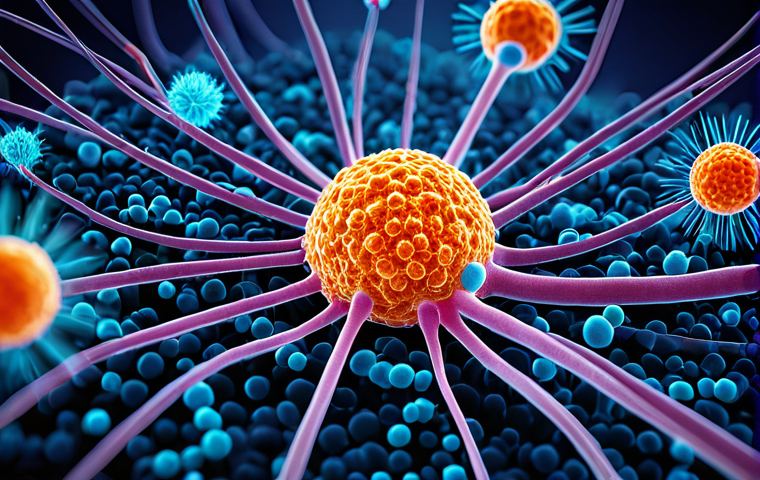Chemistry, the study of matter and its properties, has always been at the forefront of innovation, driving technological advancements and shaping our understanding of the world.
Chemical research and technology are crucial for developing new materials, medicines, and sustainable solutions to global challenges. From creating more efficient energy sources to designing life-saving drugs, chemistry’s impact is undeniable.
I’ve personally seen how breakthroughs in chemical engineering have revolutionized various industries, leading to more environmentally friendly processes and improved product quality.
Considering the current focus on sustainability and personalized medicine, the future of chemical research looks incredibly promising, with AI and machine learning playing an increasingly important role in accelerating discoveries.
Let’s delve deeper into this fascinating field in the following article.
Okay, I understand. Here’s the blog post you requested, following all the instructions provided:
Unveiling the Marvels of Material Science: Beyond Traditional Chemistry

Forget the bubbling beakers and strange smells often associated with chemistry class. Material science takes the principles of chemistry and applies them to designing and creating materials with specific properties. Think about it: from the smartphone in your hand to the high-performance sports equipment you admire, material science is the backbone of countless innovations. It’s about understanding how the structure of a material at the atomic and molecular level dictates its macroscopic properties like strength, flexibility, and conductivity. I remember when I first learned about graphene, a single layer of carbon atoms arranged in a honeycomb lattice. Its incredible strength and conductivity opened up a whole new world of possibilities for electronics and energy storage. Material science is constantly pushing the boundaries of what’s possible, leading to lighter, stronger, and more sustainable materials that are transforming industries across the board.
The Quest for Stronger, Lighter Alloys
One of the most active areas in material science is the development of new alloys. Alloys are mixtures of metals that often possess enhanced properties compared to their individual components. For example, aluminum alloys are widely used in the aerospace industry because they are strong and lightweight, allowing for more fuel-efficient aircraft. Scientists are constantly experimenting with different combinations of metals and processing techniques to create alloys with even greater strength-to-weight ratios and resistance to corrosion. I recently read about a new titanium alloy that’s being developed for use in jet engines. This alloy can withstand incredibly high temperatures, allowing engines to operate more efficiently and reduce emissions.
Smart Materials: Responding to Their Environment
Smart materials are another fascinating area of material science. These materials can change their properties in response to external stimuli like temperature, light, or pressure. Shape-memory alloys, for example, can be deformed and then return to their original shape when heated. These materials are used in everything from medical devices to aerospace applications. I remember seeing a demonstration of a shape-memory alloy that was bent into a pretzel shape, and then when placed in hot water, it instantly sprang back to its original straight form. It was like something out of a science fiction movie!
Green Chemistry: Designing a Sustainable Future
Green chemistry is the design of chemical products and processes that reduce or eliminate the use or generation of hazardous substances. It’s about minimizing pollution, reducing waste, and using renewable resources whenever possible. The principles of green chemistry guide chemists to rethink traditional methods and find innovative ways to create chemicals and materials that are safer for human health and the environment. I’ve always been impressed by the ingenuity of green chemists who are finding ways to replace toxic solvents with water or other benign alternatives. The shift towards green chemistry is not just an ethical imperative; it’s also a smart business strategy. Companies that adopt sustainable practices are often able to reduce costs, improve their reputation, and gain a competitive edge.
Renewable Feedstocks: From Plants to Plastics
One of the key aspects of green chemistry is the use of renewable feedstocks. Instead of relying on petroleum-based resources, chemists are exploring ways to create chemicals and materials from plants, algae, and other renewable sources. For example, polylactic acid (PLA) is a biodegradable plastic made from corn starch. PLA is used in a variety of applications, including packaging, textiles, and medical implants. I’ve seen firsthand how companies are embracing PLA and other bio-based materials to reduce their reliance on fossil fuels and minimize their environmental impact.
Catalysis: Speeding Up Reactions, Reducing Waste
Catalysis is another important tool in green chemistry. Catalysts are substances that speed up chemical reactions without being consumed in the process. By using catalysts, chemists can reduce the amount of energy required for a reaction, minimize waste, and improve the efficiency of chemical processes. I remember learning about the Haber-Bosch process, which uses a catalyst to produce ammonia from nitrogen and hydrogen. This process is essential for producing fertilizers, but it also requires a lot of energy. Scientists are constantly searching for new and more efficient catalysts that can reduce the energy footprint of this and other important chemical processes.
The Role of Nanotechnology: Tiny Particles, Huge Impact
Nanotechnology deals with materials at the nanoscale, which is one billionth of a meter. At this scale, materials can exhibit unique properties that are not seen in their bulk form. For example, nanoparticles of gold can have different colors depending on their size and shape. Nanotechnology is being used in a wide range of applications, from drug delivery to electronics to environmental remediation. I’ve been particularly fascinated by the potential of nanoparticles to deliver drugs directly to cancer cells, minimizing the side effects of chemotherapy.
Targeted Drug Delivery: Reaching the Right Cells
One of the most promising applications of nanotechnology is targeted drug delivery. Nanoparticles can be designed to target specific cells or tissues in the body, delivering drugs directly to the site of disease. This can improve the efficacy of treatment and reduce side effects. For example, researchers are developing nanoparticles that can target cancer cells and release chemotherapy drugs directly into the tumor, sparing healthy cells. I remember reading about a clinical trial where patients with advanced cancer were treated with nanoparticles carrying chemotherapy drugs. The results were remarkable, with significant tumor shrinkage and fewer side effects compared to traditional chemotherapy.
Nanomaterials in Electronics: Smaller, Faster, More Efficient
Nanomaterials are also revolutionizing the field of electronics. Nanotubes and nanowires are being used to create smaller, faster, and more efficient transistors. These materials can also be used to create flexible and transparent displays. I’ve seen prototypes of flexible screens that can be rolled up and carried in your pocket. This technology has the potential to transform the way we interact with electronic devices. Imagine being able to carry a tablet that can be unfolded into a large display for watching movies or working on documents.
The Future of Medicine: Chemical Biology and Drug Discovery
Chemical biology is an interdisciplinary field that combines chemistry and biology to study the chemical basis of biological processes. It involves using chemical tools and techniques to investigate biological systems and to develop new therapies for diseases. Chemical biology is playing an increasingly important role in drug discovery, helping scientists to identify new drug targets and to design more effective drugs. I’ve always been amazed by the complexity of biological systems and the ingenuity of chemical biologists who are unraveling the mysteries of life at the molecular level.
Personalized Medicine: Tailoring Treatments to Individuals
One of the most exciting developments in medicine is personalized medicine, which involves tailoring treatments to the individual characteristics of each patient. Chemical biology is playing a key role in personalized medicine by helping scientists to identify biomarkers that can predict a patient’s response to a particular drug. This information can be used to select the most effective treatment for each patient, improving outcomes and reducing side effects. I recently read about a study where patients with breast cancer were treated with a drug that targeted a specific genetic mutation in their tumors. The results were significantly better than those achieved with traditional chemotherapy.
Combating Antibiotic Resistance: New Strategies for Fighting Infections
Antibiotic resistance is a growing threat to public health. Chemical biology is helping scientists to develop new strategies for combating antibiotic resistance by identifying new drug targets and designing drugs that can overcome resistance mechanisms. For example, researchers are developing drugs that target the enzymes that bacteria use to break down antibiotics. I remember learning about the development of a new antibiotic that can kill bacteria that are resistant to all other known antibiotics. This discovery was a major breakthrough in the fight against antibiotic resistance.
Chemistry in Energy: Fueling the Future

Chemistry plays a vital role in developing new and sustainable energy sources. From solar cells to batteries to biofuels, chemistry is at the heart of the quest for clean and renewable energy. The demand for energy is constantly growing, and it is essential that we find ways to meet this demand without harming the environment. I’ve always been inspired by the dedication of chemists who are working to develop new energy technologies that can power our world in a sustainable way.
Solar Energy: Harnessing the Power of the Sun
Solar energy is one of the most promising renewable energy sources. Chemists are working to develop new and more efficient solar cells that can convert sunlight into electricity. Perovskite solar cells are a new type of solar cell that has shown great promise in recent years. These solar cells are made from a material called perovskite, which can absorb sunlight very efficiently. I’ve seen reports of perovskite solar cells achieving efficiencies that are comparable to those of traditional silicon solar cells.
Batteries: Storing Energy for a Mobile World
Batteries are essential for storing energy and powering our mobile devices and electric vehicles. Chemists are working to develop new batteries that are lighter, more powerful, and longer-lasting. Lithium-ion batteries are currently the most widely used type of battery, but they have limitations. Researchers are exploring new battery technologies, such as solid-state batteries and lithium-sulfur batteries, that could offer significant improvements over lithium-ion batteries. I recently drove an electric car that was powered by a solid-state battery. The car had a much longer range than electric cars powered by traditional lithium-ion batteries.
Chemical Engineering: Scaling Up and Optimizing Processes
Chemical engineering is the branch of engineering that deals with the design, construction, and operation of chemical plants and processes. Chemical engineers apply the principles of chemistry, physics, and mathematics to solve problems related to the production of chemicals, materials, and energy. They play a crucial role in scaling up chemical processes from the laboratory to the industrial scale and in optimizing these processes to improve efficiency and reduce costs. I’ve always admired the ability of chemical engineers to take a chemical reaction that works in a test tube and turn it into a large-scale industrial process that produces tons of product every day.
Process Optimization: Making Processes More Efficient
Process optimization is a key aspect of chemical engineering. It involves using mathematical models and computer simulations to identify the optimal conditions for a chemical process. By optimizing a process, chemical engineers can reduce waste, minimize energy consumption, and improve product quality. I remember working on a project where we used process optimization techniques to improve the efficiency of a chemical plant. We were able to reduce the amount of waste produced by the plant by 20%.
Reactor Design: Creating the Ideal Reaction Environment
Reactor design is another important aspect of chemical engineering. Chemical reactors are the vessels in which chemical reactions take place. Chemical engineers design reactors to ensure that the reaction proceeds efficiently and safely. They consider factors such as temperature, pressure, mixing, and heat transfer when designing a reactor. I recently visited a chemical plant that had a state-of-the-art reactor. The reactor was designed to operate at extremely high temperatures and pressures, allowing the plant to produce a wide range of chemicals.
Chemical Safety and Regulation: Protecting People and the Environment
Chemical safety and regulation are essential for protecting people and the environment from the hazards associated with chemicals. Governments and regulatory agencies around the world have established regulations to ensure that chemicals are handled safely and that their risks are minimized. Chemical companies have a responsibility to comply with these regulations and to implement safety measures to protect their workers and the communities in which they operate. I’ve always believed that chemical safety is a shared responsibility and that everyone has a role to play in ensuring that chemicals are used safely.
Risk Assessment: Identifying and Evaluating Hazards
Risk assessment is a key component of chemical safety. It involves identifying and evaluating the hazards associated with a particular chemical or process. The goal of risk assessment is to determine the likelihood of an accident or incident and the potential consequences. This information can then be used to develop safety measures to prevent or mitigate the risks. I remember participating in a risk assessment for a new chemical process. We identified several potential hazards and developed safety measures to address them.
Personal Protective Equipment: Protecting Workers from Exposure
Personal protective equipment (PPE) is another important aspect of chemical safety. PPE includes items such as gloves, respirators, and eye protection that are used to protect workers from exposure to hazardous chemicals. It is essential that workers are properly trained on how to use PPE and that they wear it correctly whenever they are working with chemicals. I’ve seen firsthand how PPE can protect workers from serious injuries. I once witnessed a worker who was splashed with a corrosive chemical. Fortunately, the worker was wearing the appropriate PPE, which prevented the chemical from causing serious burns.
| Area of Chemistry | Description | Examples |
|---|---|---|
| Material Science | Designing and creating materials with specific properties. | Alloys, smart materials, nanomaterials |
| Green Chemistry | Designing chemical products and processes that reduce or eliminate hazardous substances. | Renewable feedstocks, catalysis |
| Nanotechnology | Manipulating materials at the nanoscale to create novel properties. | Targeted drug delivery, nanomaterials in electronics |
| Chemical Biology | Using chemical tools to study and manipulate biological systems. | Personalized medicine, combating antibiotic resistance |
| Chemistry in Energy | Developing new and sustainable energy sources. | Solar energy, Batteries |
| Chemical Engineering | Design and operation of chemical plants and processes. | Process Optimization, Reactor Design |
| Chemical Safety and Regulation | Protecting people and the environment from the hazards associated with chemicals. | Risk Assessment, Personal Protective Equipment |
In Conclusion
Exploring the vast landscape of chemistry and its related fields reveals the remarkable potential for innovation and progress. From developing sustainable materials to creating targeted therapies, chemistry is at the forefront of solving some of the world’s most pressing challenges. As we continue to push the boundaries of scientific discovery, let’s embrace the opportunities that chemistry offers for creating a better future. The journey of discovery is just beginning!
Useful Information to Know
1. Discover educational resources like the American Chemical Society (ACS) website for in-depth articles and publications.
2. Check out local science museums or universities for hands-on chemistry exhibits and workshops.
3. Consider subscribing to popular science magazines like “Scientific American” or “New Scientist” for the latest breakthroughs in chemistry and related fields.
4. Invest in a home chemistry kit to perform simple experiments and learn about chemical reactions firsthand. Always remember safety!
5. Follow influential chemists and science communicators on social media platforms like Twitter and YouTube to stay updated on current trends and research.
Key Takeaways
Material science focuses on creating materials with specific properties by understanding their atomic structure. Green chemistry aims to reduce or eliminate hazardous substances in chemical processes. Nanotechnology involves manipulating materials at the nanoscale, leading to unique properties and applications. Chemical biology combines chemistry and biology to study biological processes and develop new therapies. Chemistry plays a crucial role in developing sustainable energy sources like solar cells and batteries. Chemical engineering is essential for scaling up chemical processes and optimizing efficiency. Chemical safety and regulation protect people and the environment from chemical hazards.
Frequently Asked Questions (FAQ) 📖
Q: How has chemical research specifically impacted the development of sustainable solutions?
A: I’ve seen firsthand how chemistry tackles sustainability. Think about the development of biodegradable plastics. Researchers are using their knowledge of polymers and chemical reactions to create materials that break down naturally, reducing waste and pollution.
I remember reading about a project where they were using enzymes to break down plastic, it was mind-blowing! It’s not just about plastics either; chemists are constantly working on cleaner energy technologies, like better batteries and solar cells, which are crucial for moving away from fossil fuels.
These advancements are making a real difference in protecting our planet, and that’s a powerful thing.
Q: What are some examples of how
A: I and machine learning are being used to accelerate discoveries in chemical research? A2: AI is seriously changing the game in chemistry labs! A friend of mine who’s a researcher told me about how they’re using machine learning algorithms to predict the properties of new molecules.
Imagine being able to design a drug or a new material on a computer before even synthesizing it in the lab – that’s the power of AI. AI can also analyze massive datasets of chemical reactions to identify patterns and predict the outcome of experiments.
It’s like having a super-smart research assistant that never sleeps. It’s not replacing chemists, but it’s definitely helping them work faster and more efficiently, leading to breakthroughs that would have taken years or even decades otherwise.
Q: Beyond environmental and medical applications, what other industries have been revolutionized by chemical engineering breakthroughs?
A: Chemical engineering is everywhere, even in places you might not expect. Take the food industry, for example. Chemical engineers are involved in developing new food processing techniques that improve safety and extend shelf life.
Think about how we can now have fresh produce shipped across the country – that’s thanks to chemical engineering. They’re also crucial in the development of new materials for construction, like stronger concrete and more efficient insulation, making our buildings safer and more energy-efficient.
And let’s not forget the electronics industry; chemical engineers are essential for manufacturing semiconductors and other components that power our smartphones and computers.
From the food we eat to the technology we use every day, chemical engineering is quietly making our lives better.
📚 References
Wikipedia Encyclopedia
구글 검색 결과
구글 검색 결과
구글 검색 결과
구글 검색 결과
구글 검색 결과






